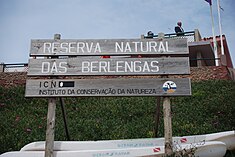Berlengas
| Berlengas | |
| Archipelago (Arquipélago) | |
|
Berlenga Grande is part of the Reserva Natural das Berlengas, a protected area home to marine species of flora and fauna
|
|
| Official name: Arquipélago das Berlengas | |
| Nickname: Ilhas das Berlengas | |
| Country | |
|---|---|
| Region | Beira |
| Sub-region | Oeste |
| District | Leiria |
| Municipality | Peniche |
| Location | Atlantic Ocean |
| Islands | Berlenga Grande, Estelas, Farilhões, Forcados |
| Landmark | Fort of São João Baptista |
| Highest point | Berlenga Grande |
| - elevation | 75 m (246 ft) |
| - coordinates | 39°24′55″N 9°30′34″W / 39.41528°N 9.50944°W |
| Lowest point | Sea level |
| - location | Atlantic Ocean |
| - elevation | 0 m (0 ft) |
| Length | 1.99 km (1 mi), Northwest-Southeast |
| Width | 8.57 km (5 mi), Southwest-Northeast |
| Area | 0.99 km2 (0 sq mi) |
| Biomes | Temperate, Mediterranean |
| Ethnic groups | Portuguese |
|
Location of the archipelago of the Berlengas
|
|
The Berlengas archipelago is a group of small islands 10 to 15 kilometres (6.2–9.3 miles) off the Portuguese coast, west of the town of Peniche in Oeste region. These islands were traditionally known to British mariners as "the Burlings". The only habitable island is the largest island, Berlenga Grande, although there is no permanent habitation there at present. The other islands are grouped into two groups of islets, the Estelas Islets and the Farilhões-Forcados Islets.
Human occupation on Berlenga Grande dates back to antiquity: the islands are referred to in Ptolemy's Geography as Λονδοβρίς (Londobris). Much later it was referred to as the island of Saturno by Roman geographers, and was visited successively by Muslims, Vikings and pirates/privateers from England and France.
In 1513, with the support of Queen Eleanor of Viseu, monks from the Order of São Jerónimo established a settlement on the island to offer assistance to navigation and victims of frequent shipwrecks. The monastery founded there (the Monastery of the Misericórdia da Berlenga), remained until the 16th century, when disease, lack of communication (due to constant inclement weather) and regular assaults by pirates and privateers (from England and France), forced the monks to abandon their service on the island.
After the Portuguese Restoration War, during the reign of King John IV, the Counsel of War determined that the demolition of the monastery ruins, and the use of their rocks to build a coastal defense would help protect the coastal settlements; the Fort of São João Baptista das Berlengas was constructed from the remnants of the monastery ruins. By 1655, it had already, during its construction, resisted an assault by three Barbary coast pirates.
...
Wikipedia


